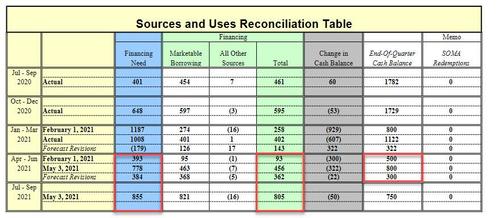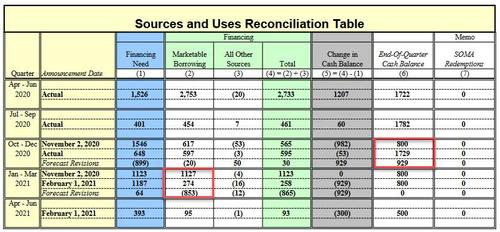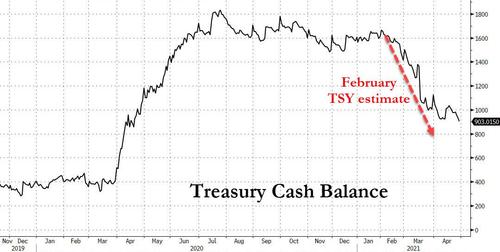
by Tyler Durden at ZeroHedge
Three months ago, the Treasury surprised markets when in its quarterly borrowing forecast, it revealed that in the first calendar quarter of 2021, it wouldn’t need to borrow as much debt as it had recently because the Treasury’s cash balance (held in the Treasury General Account, or TGA, which is simply the Treasury’s cash balance held at the Fed) would plunge to just $800 billion, down a record $929BN from $1.729 trillion at Dec 31, 2020.
This forecast for a flood of liquidity emanating from the Treasury prompted us (and subsequently others) to predict that as a result of the “mind-boggling liquidity” of just under $1 trillion in cash set to be unleashed by the Biden admin, stocks would soar as the Treasury’s monetary injection would be far bigger than the $120BN in liquidity injected by the Fed every month.
And while stocks indeed surged to new all time highs, the Treasury’s cash flood plan stumbled as the latest, just released Treasury Marketable Borrowing Estimates have revealed.
According to the Treasury, during the January – March 2021 quarter, Treasury borrowed $401 billion in privately-held net marketable debt – $126 billion more than the $274 billion originally forecast – and ended the quarter with a cash balance of $1.122 trillion, some $322 trillion more than the $800 billion it had forecast back in February (red arrow below), although as shown in the chart below, the actual TGA cash balance is indeed sliding fast, if not quite as fast as expected three months ago.
According to the Treasury, the $126 billion increase in borrowing resulted primarily from the increase in the end-of-March cash balance somewhat offset by lower net expenditures.
So what does the Treasury expect will happen in the current and coming quarter? Here is the summary from the latest Sources and Uses:
- During the April – June 2021 quarter, Treasury expects to borrow $463 billion in privately- held net marketable debt, assuming an end-of-June cash balance of $800 billion. The borrowing estimate is $368 billion higher than announced in February 2021, primarily due to the government’s additional response to the COVID-19 pandemic.
- The Treasury now expects $800BN in cash at June 30, just $100BN less than the latest print of $903BN as of the end of April. This means that the Cash flood which saw the TGA balance decline by $700BN since the start of the year is about to slow to a tricke.
- Treasury is assuming a cash balance of approximately $450 billion at the expiration of the debt limit suspension on July 31 based on expected outflows under its cash management policies and consistent with its authorities and obligations, including the Bipartisan Budget Act of 2019. It notes that “the actual cash balance on July 31 may vary from this assumption based on changes to expected outflows in that period.”
- During the July – September 2021 quarter, Treasury expects to borrow $821 billion in privately-held net marketable debt, assuming an end-of-September cash balance of $750 billion.
Of note here: the Treasury almost quintupled its borrowing estimate for the quarter through June, and now expects to borrow $1.3 trillion over the second half of the fiscal year to help pay for a raft of fresh pandemic-relief spending. The Treasury’s projections incorporated the impact of Biden’s $1.9 trillion pandemic-relief bill; in its February outlook the Treasury left out any guess on such spending.
Meanwhile on the cash side, ahead of Monday’s release some strategists speculated that the Treasury may return its cash balance to where it had been when Congress suspended the federal debt limit was suspended, around $130 billion, unless lawmakers lifted or suspended the ceiling again. It now appears that the Treasury will go for a far bigger cash buffer, as officials assumed an increase or suspension of the ceiling in their projection for $750 billion in cash for the end of September.
In summary, instead of dropping by $929BN through March 31 as it had expected in February, the Treasury cash balance declined by “only” $607BN, a difference of $322BN. And in the current quarter, the Treasury now expects a similar decline in cash as last quarter, a drop of $322BN (vs $300BN previously), although since it is starting from a higher base, the June 30 cash balance will be $800BN instead of $500BN. This is summarized in the table below:
Finally, here is the full Sources and Uses Reconciliation, showing changes to not only cash, but financing needs and actual debt balances.

To be sure, not everyone believes the latest projections: “These projections are difficult to rely on,” Jefferies analysts Thomas Simonsand Aneta Markowska wrote in a note Monday. “There is a significant amount of risk surrounding the size and pacing of tax receipts during the quarter and outlays related to the stimulus as well. These projections should be viewed in the context that the outlook for financing changes on a daily basis.”
We will have more to say on this in a subsequent post, but for now the…
Continue Reading


